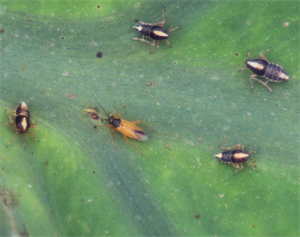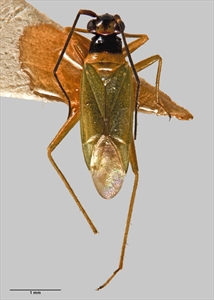Egg-sucking bug
Pacific Pests, Pathogens and Weeds - Online edition
Pacific Pests, Pathogens & Weeds
Taro egg-sucking bug (399)
Cyrtorhinus fulvus
Southeast Asia (Indonesia, Philippines), North America (Hawaii), Oceania. It is recorded from American Samoa, Fiji, French Polynesia, Guam, Papua New Guinea, Samoa, Solomon Islands, Tonga, Tuvalu (uncertain), and Vanuatu.
Tarophagus species; it is likely that it preys on all three species recorded: Tarophagus proserpina, Tarophagus persephone and Tarophagus colacasiae. Until recently, however, only a single species, Tarophagus proserpina, was recognised.
Waterhouse & Norris (1987) consider this mirid bug to be 'probably specific' to Tarophagus species. Both the adults and nymphs puncture the eggs of the taro planthopper, which are laid in the leaf stalks and main veins, and suck out the contents. The adult bug is 3 mm long, with black antennae, head, and pronotum (the area behind the head and over the thorax) (Photos 1&2). The abdomen is yellow becoming pink towards the back. The legs and hardened part of the wings (nearest the body) are orange; the membranous parts (furthest from the body) are black. Nymphs are similar but without wings.
Eggs are laid into the leaf or into the collapsed eggs of the planthopper. Eggs hatch in 1 to 2 weeks and there are five nymph stages.
Spread of the bug is on the wing, and as eggs in the movement of planting material.
Good control of Tarophagus by Cyrtorhinus is reported from American Samoa, Fiji, Samoa, Guam, and Pohnpei (FSM). As Swaine (1971) says: "Generally effective, but localised outbreaks of the planthopper [Tarophagus] still occur [in Fiji]". Although it is said that there is a good relationship between the bug and its planthopper prey in different locations and over seasons, there are reports of large numbers of both Cyrtorhinus and Tarophagus on taro in Solomon Islands and Vanuatu, especially in dry weather.
Unfortunately, Cyrtorhinus is unlikely to reduce Tarophagus populations to levels that prevent or even reduce spread of viruses (i.e., Taro vein chlorosis virus and Taro Colocasia bobone virus).
Look for a fast moving bug with black head and antennae and orange wings among Tarophagus colonies on leaf blades and stalks.
RELEASES OF CYRTORHINUS
The bug has been introduced to the following countries: French Polynesia (1951, 1961); Guam (1947); Hawaii (1938); Pohnpei (Federated States of Micronesia); Samoa (c.1947); Tuvalu (1983), and Wallis and Futuna (1950s). Some releases are said to have failed, perhaps due to different distributions of Tarophagus species in Pacific island countries.
PEST RISK ASSESSMENT
Even though it appears that Cyrtorhinus fulvus is 'probably specific' to Tarophagus on taro, that does not mean that a risk assessment to check undesirable effects on non-target species is unwarranted.
CYRTORHINUS AND THE USE OF INSECTICIDES
Poor results from releases of Cyrtorhinus have been reported from some countries, but the reasons are unknown. Possibly, it is due to the use of insecticides. Avoid the use of organophosphate, carbamate and synthetic pyrethroid insecticides. If these pesticides have been used, leave at least 4 weeks before Cyrtorhinus are released.
AUTHOR Grahame Jackson
Information from Waterhouse DF, Norris KR (1987) Biological Control Pacific Prospects. Inkata Press; and Swaine G (1971) Agricultural Zoology in Fiji. Her Majesty's Stationery Office. London; and from CABI (2018) Cyrtorhinus fulvus. Crop Protection Compendium. (https://www.cabi.org/cpc/datasheet/17538). Photo 2 Woodward TE (1950) Cyrtorhinus cumberi Woordward 1950. Auckland War Memorial Museum. New Zealand. (https://commons.wikimedia.org/wiki/File:Cyrtorhinus_cumberi_Woodward,_1950_(AM_AMNZ21727-1).jpg).
Produced with support from the Australian Centre for International Agricultural Research under project HORT/2016/18: Responding to emerging pest and disease threats to horticulture in the Pacific islands, implemented by the University of Queensland and the Pacific Community.





